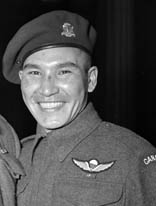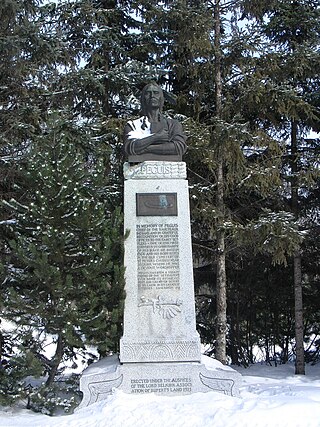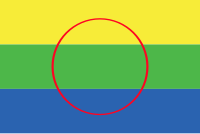
The Saulteaux, otherwise known as the Plains Ojibwe, are a First Nations band government in Ontario, Manitoba, Saskatchewan, Alberta and British Columbia, Canada. They are a branch of the Ojibwe who pushed west. They formed a mixed culture of woodlands and plains Indigenous customs and traditions.

Thomas George Prince MM SSM was an Indigenous Canadian war hero and the most decorated soldier in the First Special Service Force or Devil's Brigade, an elite American-Canadian commando unit, during World War II. He was Canada's most decorated First Nations soldier, serving in World War II and the Korean War. Prince's military deeds as a scout and as a forward combatant were unique and of major strategic importance.
Jerry Fontaine is an Anishinaabe politician in Manitoba, Canada. He was chief of the Sagkeeng First Nation from 1989 to 1998, led the First Peoples Party in the 1995 provincial election, and was an unsuccessful candidate to lead the Manitoba Liberal Party in 1998. He was the director of Indigenous Initiatives at Algoma University from 2004-2008.
A tribal council is an association of First Nations bands in Canada, generally along regional, ethnic or linguistic lines.
Treaty Five is a treaty between Queen Victoria and Saulteaux and Swampy Cree non-treaty band governments and peoples around Lake Winnipeg in the District of Keewatin. Much of what is today central and northern Manitoba was covered by the treaty, as were a few small adjoining portions of the present-day provinces of Saskatchewan and Ontario.
First Nations in Manitoba constitute of over 160,000 registered persons as of 2021, about 57% of whom live on reserve. Manitoba is second to Ontario in total on-reserve population and in total First Nation population.

The Muskoday First Nation is a First Nation band government in Saskatchewan, Canada, composed of Cree and Saulteaux peoples. The First Nation has a registered population of 1,828 people as of September 2014, of which approximately 623 members of the First Nation live on-reserve, and approximately 1204 live off-reserve. Muskoday's territory is located in the aspen parkland biome. It is bordered by the rural municipalities of Birch Hills No. 460 and Prince Albert No. 461.
East Selkirk is a community of 675 in the Rural Municipality (RM) of St. Clements in the Canadian province of Manitoba. It is directly across the Red River from Selkirk, Manitoba.

Treaty 4 is a treaty established between Queen Victoria and the Cree and Saulteaux First Nation band governments. The area covered by Treaty 4 represents most of current day southern Saskatchewan, plus small portions of what are today western Manitoba and southeastern Alberta. This treaty is also called the Qu'Appelle Treaty, as its first signings were conducted at Fort Qu'Appelle, North-West Territories, on 15 September 1874. Additional signings or adhesions continued until September 1877. This treaty is the only indigenous treaty in Canada that has a corresponding indigenous interpretation.

Treaty 1 is an agreement established on August 3, 1871, between the Imperial Crown of Great Britain and Ireland and the Anishinabe and Swampy Cree nations. The first of a series of treaties called the Numbered Treaties that occurred between 1871–1921, this accord has been held to be essentially about peace and friendship. However, the eight days of treaty-making ended with the indigenous groups agreeing to "cede, release, surrender and yield up to Her Majesty the Queen and successors forever all the lands" in southern Manitoba to the Crown, in exchange for an annual annuity and material goods such as clothing and agricultural supplies.

The Council of Keewatin was an unelected legislative body and territorial government for the now defunct District of Keewatin in Canada. The District of Keewatin was created by the passage of the Keewatin Act on October 7, 1876 from a portion of Canada's North West Territories. Lieutenant Governor Alexander Morris convinced the government that the new territorial government of the North West Territories would be unable to effectively administer land to the north and east of Manitoba. Shortly after the District of Keewatin was formed a large group of Icelanders arrived, infected with smallpox which quickly spread to the indigenous First Nation population. The Government of Canada allowed the Council to be formed for the purpose of containing the smallpox epidemic. The Council also administered Indian treaty claims, immigrant land claims, Hudson's Bay Company trading post concerns as well as policing and health care. The Council lasted from November 25, 1876, until April 16, 1877, after which control of the territory was returned under federal authority.
The Pine Creek First Nation is a Saulteaux First Nation in Manitoba, Canada. The First Nation's homeland is the Pine Creek 66A reserve, located approximately 110 kilometres north of Dauphin along the southwestern shore of Lake Winnipegosis between the communities of Camperville and Duck Bay. The Rural Municipality of Mountain (South) borders it on the southwest.

Calvin Murray Sinclair, is a former member of the Canadian Senate and First Nations lawyer who served as chairman of the Indian Residential Schools Truth and Reconciliation Commission from 2009 to 2015. He previously served as a judge in Manitoba from 1988 to 2009, being the first Indigenous judge appointed in the province. Sinclair was appointed to the Senate of Canada on April 2, 2016. In November 2020, he announced his retirement from the Senate effective January 31, 2021.
Skownan First Nation is a Saulteaux (Ojibwe) First Nations band government whose reserve community, Waterhen 45, is located 288 km north of Winnipeg, Manitoba, Canada, on the south shore of Waterhen Lake, between Lake Winnipeg and Lake Winnipegosis. As of May, 2015, the First Nation had 1,464 registered members, of which 750 lived on-reserve.
Robert James Speers was a Canadian businessman and Canada's Sports Hall of Fame inductee who made a major contribution to the growth of Thoroughbred horse racing in Western Canada.

Peguis was a Saulteaux chief, who moved from the Great Lakes area to Red Lake, then arriving in what is now southern Manitoba in the 1790s.
Fisher River is a Cree First Nations reserve located approximately 193 km north of Manitoba's capital city, Winnipeg. The Fisher River Cree Nation is composed of two reserves; Fisher River 44 and Fisher River 44A. The reserve population is 1945, the off reserve population is 1934 for a total of 3879 band members as of June 2017. Fisher River is 15,614 acres.

The Cote First Nation is a Saulteaux First Nations band government in Kamsack, Saskatchewan. This Saulteaux reserve is connected to the Keeseekoose First Nation and only a couple of miles from the Key First Nation. Their land is situated just south of the boreal forest in the aspen parkland ecosystem of Canada. The Ojibwe of this region of Saskatchewan and Manitoba were both hunters of the plains bison and hunters of the forests which were more abundant during the 19th century. They also fished the endless lakes and other waterways in the land. They seldom went hungry as a result of the large bison herds. However, by the 1870s, commercial hunting had reduced the bison to near extinction and the Ojibwe of Saskatchewan and Manitoba began to suffer from famine.
Henry Prince, born Pa-bat-or-kok-or-sis or Mis-koo-kenew, was a Saulteaux Indian chief of the Peguis First Nation.

William Prince is a Canadian folk and country singer-songwriter based in Winnipeg, Manitoba.











